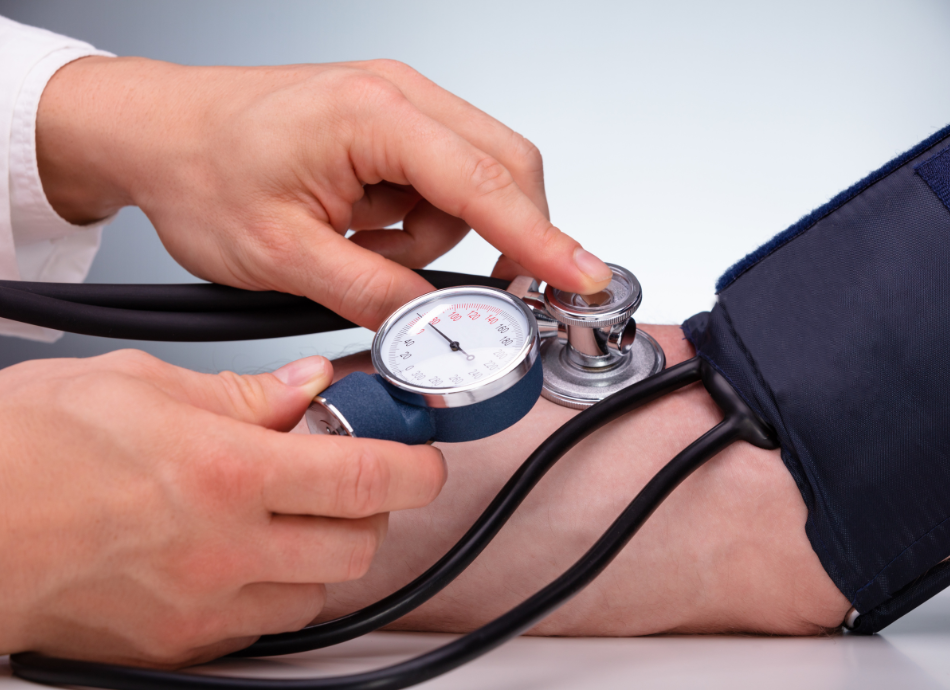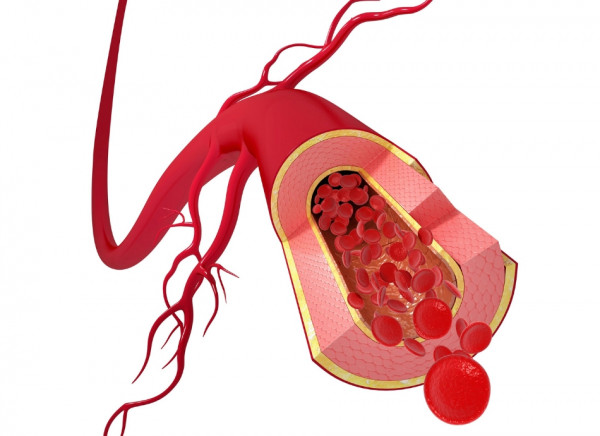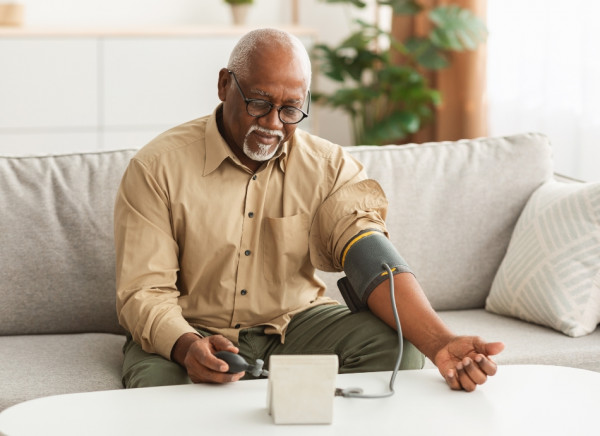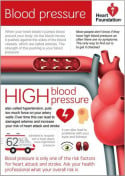High blood pressure | Mate pēhanga toto
Also known as hypertension
Key points about high blood pressure (hypertension)
- High blood pressure (mate pēhanga toto) is a common condition in which the force of your blood against your artery walls is too high, for too long.
- Ongoing high blood pressure puts stress on your heart and blood vessels and can lead to health problems, eg, heart disease and stroke.
- You can feel fine, have high blood pressure and not know it, so get your blood pressure checked regularly. Your usual healthcare provider or pharmacist can do this for you.

- At least 1 in 5 New Zealanders has high blood pressure, but most don't know they have it.
- High blood pressure usually doesn't cause symptoms, so the best way to find out if you have high blood pressure is to get your blood pressure checked regularly. Your doctor, nurse or pharmacist can do this for you.
- Untreated high blood pressure can cause serious problems including stroke, heart attack, kidney failure and blood vessel damage.
- You can manage high blood pressure through healthy lifestyle choices and medications if needed.
- If you need medicine for blood pressure, take it every day as prescribed. If you have any questions, ask your prescriber or pharmacist.
The image below shows a healthy artery allowing good blood flow.

Image credit: Canva
Click on the link from the American Heart Association below to see how high blood pressure affects your arteries and heart.
High blood pressure and the cardiovascular system(external link).
Blood pressure (pēhanga toto) is the force of your blood pushing against the walls of your arteries. Think about it like water pressure inside a hose. Read more about blood pressure.
Blood pressure is measured in millimetres of mercury (which is written as mmHg). Blood pressure readings are a combination of two measurements:
- Systolic – the highest pressure against your arteries as your heart pumps. The normal systolic pressure is usually between 110–130 mmHg.
- Diastolic – the pressure against your arteries as your heart relaxes and fills with blood. The normal diastolic pressure is usually between 70–80 mmHg.
Blood pressure readings are described as the systolic pressure over the diastolic pressure so you may be told it's 130 over 78 for example. That would be written as 130/78.
If your blood pressure is 140/90 mmHg or higher, it's considered to be high blood pressure. However, it's difficult to give an exact example of a high blood pressure reading, because it depends on the individual and what activity you're doing – blood pressure normally changes with things like stress and exercise.
The level of blood pressure that's high for you depends on lots of different factors and your overall risk of heart attack or stroke. Generally, the lower your blood pressure, the better. If you have a history of heart disease, diabetes or a high risk of heart attack or stroke, it's recommended you lower your blood pressure to less than 130/80.
A single high blood pressure reading doesn't necessarily mean you have high blood pressure. It's normal for your blood pressure to rise and fall during the day, depending on what you've been doing (eg, exercise) and how you're feeling (eg, stressed).
You are usually considered to have high blood pressure if your blood pressure stays high for 3 separate readings, over at least 3 months. For some people, doing measurements at home with a machine can be more accurate than doing it in the clinic with your doctor or nurse.

Image credit Canva
To find out if you need to do something about your blood pressure levels, visit your healthcare provider and have a heart and diabetes check. During your check, they will discuss your ideal blood pressure, taking into account your overall risk of having a heart attack or stroke.
Over time, high blood pressure damages your blood vessels. It can lead to the following complications.

Image credit: 123RF
| Complications of having high blood pressure | Description |
|---|---|
| Heart attack
|
High blood pressure damages arteries that can become blocked and prevent blood flow to the heart muscle. |
| Angina | High blood pressure can damage the small blood vessels supplying your heart itself, leading to angina, or chest pain. |
| Stroke | High blood pressure can cause blood vessels in your brain to clog more easily or even burst. |
| Heart failure | The increased workload from high blood pressure can cause your heart to enlarge and fail to pump blood effectively around your body. |
| Kidney disease or kidney failure | High blood pressure can damage the arteries around your kidneys or the tiny blood vessels inside and interfere with their ability to filter blood effectively. |
| Eyesight problems | High blood pressure can strain or damage blood vessels in your eyes and can lead to loss of vision. |
| Peripheral artery disease | Atherosclerosis caused by high blood pressure can cause a narrowing of arteries in your legs, arms, stomach and head, causing pain, fatigue or even the death of muscle and skin. |
| Sexual problems | High blood pressure can lead to erectile dysfunction in men or lower libido in women. |
High blood pressure often runs in families. Sometimes kidney or glandular disease may be responsible. However, eating too much salt, drinking too much alcohol, being overweight and not moving around enough each day can also contribute to high blood pressure and heart disease.
The effects of high blood pressure on your blood vessels are made worse by:
- cigarette smoking
- high levels of saturated fat in your diet
- high blood cholesterol.
Some medicines may cause raised blood pressure or make controlling it more difficult. These medicines include:
- the combined contraceptive pill
- non-steroidal anti-inflammatories (NSAIDs)
- some nasal drops and sprays
- some cough medicines, eye drops and appetite suppressants.
Check with your doctor or pharmacist for alternatives.
Every adult should have their blood pressure checked regularly. When you should start having heart and diabetes checks depends on your age, ethnicity and other risk factors.
| Risk factors | Age to start having heart and diabetes checks | |
|---|---|---|
|
If you have no known risk factors |
Men: 45 years Women: 55 years |
|
|
If you are Māori, Pacific Peoples or South Asian1 |
Men: 30 years Women: 40 years |
|
|
If you have the following risk factors:
|
Men: 35 years Women: 45 years |
|
|
If you have diabetes (type 1 or 2) |
As part of your yearly diabetes review | |
|
If you have schizophrenia, major depressive disorder, bipolar disorder or other severe mental illness |
25 years | |
|
||
Read more about heart risk assessment.
High blood pressure doesn't usually have any symptoms, so the only way to find out is to get your blood pressure checked by your doctor, nurse or pharmacist. They will often take several readings over weeks or months to see what the trend is.
Your healthcare provider may suggest 24-hour blood pressure monitoring. This involves wearing a blood pressure unit for up to 24 hours to collect a series of blood pressure and heart-rate readings at different times of the day and night. Read more about 24-hour blood pressure monitoring(external link).
Your healthcare provider will work out your 5-year risk of cardiovascular disease (eg, heart attack or stroke) to calculate the likely benefits of lowering your blood pressure.
If you have a low risk of cardiovascular disease, following the self-care steps listed below (eg, stopping smoking, losing weight, eating a balanced diet, less salt, less alcohol and becoming more physically active) may be enough. If your risk is higher, you are likely to need medicine as well as following the self-care steps.
Self-care for high blood pressure
- Stop smoking – quitting is the most important step to reduce your risk of heart attack and stroke.
- Achieve and maintain a healthy body weight. The more overweight you are, the more strain you put on your heart and cardiovascular system. For some people, losing 5–10 kg of excess weight is enough to get your blood pressure back to normal. Check what's right for you with your healthcare provider or pharmacist.
- Eat a balanced diet low in saturated fat with whole grains, 8 servings of coloured vegetables and fruit, and 2 to 3 servings of low-fat milk or milk products a day. Learn more about the DASH eating plan(external link) to lower high blood pressure.
- Eat less salt – use herbs, spices, citrus and vinegar for flavouring and dressings, choose low-salt versions of packaged foods, avoid pickled food and salty or fatty takeaway foods. Read more about reducing salt intake. [PDF, 255 KB]
- Limit alcohol consumption and follow recommended guidelines for low-risk drinking.
- Be active every day. Find ways to put a little bit more activity in your day at every opportunity. Take the stairs at work. Park 5 minutes further away. Aim to get 30 to 60 minutes of moderate activity most days of the week. Walking, cycling and swimming are ideal. Find an activity you enjoy so you can keep it up. Find out more about getting active.
- Avoid eating large quantities of liquorice – it contains a chemical that can raise blood pressure.
See also these tips for lowering blood pressure.
Medicines for high blood pressure
Medicines can help control high blood pressure and reduce the damage from high blood pressure, but they don't cure it. Usually, medicines will need to be taken every day for life, unless losing weight and the lifestyle changes are so successful that your blood pressure returns to normal levels without medicine.
There a variety of medicines that can be used to lower blood pressure. Each of these groups of medicines works differently. Sometimes 2 or 3 medications are needed and it may take time to find the right combination and dosage. Tell your healthcare provider or pharmacist about any side effects you may have and follow instructions carefully.
Examples of medicines to treat blood pressure include:
- ACE inhibitors eg, cilazapril, lisinopril, quinapril, enalapril, perindopril.
- ARBs eg, candesartan, losartan.
- Beta blockers eg, bisoprolol, metoprolol, propranolol.
- Calcium channel blockers eg, amlodipine, diltiazem, felodipine.
- Diuretics (also called water pills) eg, bendroflumethiazide, chlortalidone, indapamide.
Read more about medicines to treat blood pressure.
Because high blood pressure puts you at increased risk of cardiovascular disease, you may also be prescribed other medicines to help reduce your risk of heart disease and stroke. Examples are:
Apps reviewed by Healthify
You may find it useful to look at some Blood pressure apps.
High blood pressure is one of the most common health problems as people get older. With a little effort, there is much you can do to reduce your risk of getting high blood pressure and the increased risk of stroke and heart disease that goes with that.
Keep to a healthy body weight
One of the key risk factors for high blood pressure is being overweight. Being overweight(external link) can make you 2 to 6 times more likely to develop high blood pressure than being in the normal weight range. Even small amounts of weight loss(external link) can make a big difference in helping to prevent and treat high blood pressure.
Be active regularly
People who are physically active have a lower risk of getting high blood pressure (20–50% lower) than people who are not active. Even light activities, if done daily, can help lower your risk. Add more activity to your day. Aim to get 30 to 60 minutes of physical activity most days of the week. Walking, cycling and swimming are ideal. Find an activity you enjoy so you can keep it up.
Look for opportunities to add a few minutes here and there – it all helps. Take the stairs whenever you can, park 5 minutes further from work, go for a walk at lunchtime or when you get home. Read more about getting active.
Eat a balanced diet
Your diet – what you eat and drink – has a real effect on your heart and blood pressure. The more healthy your eating habits are, the lower your blood pressure will be. A heart healthy diet is low in saturated fat, whole grains, 8 servings of coloured vegetables and fruit, and 2 to 3 servings of low-fat milk or milk products a day. Read more about healthy eating.
Eat less salt
Cutting back on salt also helps prevent your blood pressure from rising. Reduce your sodium intake to 2300mg of sodium a day (about 6g salt) or less. This includes sodium from processed food. Use herbs, spices, fruit and vinegar for flavouring and dressings. If you have pre-prepared foods, avoid pickled food and avoid salty or fatty takeaway foods. Read more about reducing your salt intake [PDF, 255 KB].
Limit how much alcohol you drink
Drinking too much alcohol can raise your blood pressure. Limit how much alcohol you drink and follow recommended guidelines for low-risk drinking.
Quit smoking
Being smokefree is one of the best things you can do to lower your risk of heart attack and stroke. While smoking does not directly affect your blood pressure, it will cause your arteries to narrow just as high blood pressure does. This puts you at much higher risk of heart disease and stroke.
So, if you smoke and have high blood pressure, your arteries will narrow much more quickly and your risk of a heart attack or stroke in the future is dramatically increased. Because of this, as well as for all the other effects it has on your health, it well worth giving up smoking. Read more about quitting smoking.
Reduce stress
Stress can make blood pressure go up, and over time may contribute to the cause of high blood pressure. There are many steps you can take to reduce your stress. Read more about managing stress.
Avoid eating large quantities of liquorice
Liquorice contains a chemical that can raise blood pressure. Eating more than 57g of black liquorice a day for at least 2 weeks could lead to potentially serious health problems, such as an increase in blood pressure and an irregular heart rhythm (arrhythmia).
For most people, liquorice found in foods is safe to eat and safe when consumed in small amounts for short periods of time.
The Stroke Foundation has developed He taonga, a tool to help you and your whānau maintain a healthy blood pressure and improve your hauora. He taonga is a 6-week online programme designed to provide you with the support and motivation to make lifestyle changes. The programme is delivered through weekly emails that contain advice, support and links to videos and resources.
Have a look at the free He taonga programme.(external link)
High blood pressure personal stories(external link) Health Talk online
Blood pressure and your heart(external link) Heart Foundation, NZ
High blood pressure(external link) NHS, UK
Family health history(external link) Learn Genetics (Genetic Science Learning Centre), University of Utah, US, 2015
High blood pressure and the cardiovascular system(external link) Watch, Learn, Live – Interactive Cardiovascular Library, American Heart Association
DASH(external link) Eating plan to lower high blood pressure, NIH, US
Brochures
Blood pressure information sheet(external link) Heart Foundation, NZ English(external link), te reo Māori(external link), Tongan(external link), Samoan(external link), Hindi(external link), Korean(external link)
Managing high blood pressure(external link) Heart Foundation, NZ English(external link), Chinese(external link), Korean(external link), Hindi(external link)
24 hour blood pressure monitoring(external link) Heart Foundation, NZ
Apps/tools
There are a variety of blood pressure apps available but not all blood pressure apps are safe. Here are some which the Healthify team have reviewed:
Blood pressure apps
References
- Managing high blood pressure(external link) Heart Foundation, NZ
- High blood pressure – definition, causes and symptoms(external link) Heart Research Institute, NZ
- Health threats from high blood pressure(external link) American Heart Association, 2022
- Blood pressure (high) – hypertension(external link) Better Health Channel, Australia
- What's my risk of a heart attack or stroke?(external link) Heart Foundation, NZ
- Blood pressure and hypertension in New Zealand – results from the 2008/09 Adult Nutrition Survey(external link) NZ Med J. 2013 April 5;126(1372).
- NZ health survey 2018/19(external link) Ministry of Health, NZ, 2019
- High blood pressure prevention(external link) WebMD, US, 2023
- Sodium position statement(external link) Heart Foundation, NZ
- Can eating too much black liquorice be bad for you?(external link) NHS, UK, 2022
Brochures

Blood pressure information sheet
Heart Foundation, NZ, 2023
English, te reo Māori, Tongan, Samoan, Hindi, Korean

24 hour blood pressure monitoring
Heart Foundation, NZ
Credits: Healthify editorial team. Healthify is brought to you by Health Navigator Charitable Trust.
Reviewed by: Dr Art Nahill, Consultant General Physician and Clinical Educator.
Last reviewed:






